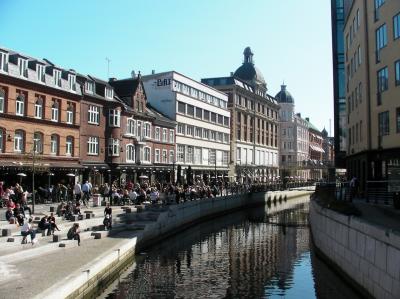
Danish tribe – cold also in summer

Do you find Lars von Trier's movies strange? Go to Denmark and you will understand. They are not fictional or exaggerated – they are just too true. And although the size and population of Denmark is similar to Slovakia, other cultural, social and economic indicators certainly are not similar.
At the beginning of spring (as a part of my semestral film internship), I attended a lecture on Danish culture and the peculiar nature of the Scandinavian tribe. At the beginning of summer, I can clearly say that most of my assumptions are met – the Danish system is so perfect, but Danish people are distant and cold in social contexts.
Life according to the script (and vice versa)
The anthropologist Dennis Nørmark from Aarhus University didn't exaggerate in any way in a lecture about his five and half million Danish family. Already in the Viking era (the 8th to 11th centuries), the Danish nation received attention abroad, and not only in a positive sense. If you do not like to read the serious texts, just take a look at film and television archive. It tells you a lot about Danes. And perhaps more than necessary. Probably you remember some films – shot according to the Danish Dogma 95 manifesto.
Danish series "Matador" (abroad translated as "Monopoly"), recorded thirty years ago, might be a crazier example. The story is set in the fictional town (coincidentally resembling Roskilde) in the period from 1929 to 1947 and follows the rivalry between the families of two businessmen. Popularity of these series in Denmark can be compared with the success of Turkish Scheherazade in Slovakia. In 2005, one million copies of the first edition DVDs with these series were sold (so every fifth Dane has it at home).
Unlimited trust in the Danish way
Danish people are not naive, they just trust each other implicitly. They know that when they leave a stroller in front of the market, it still will be there after ten minutes. When they leave a box of fruit unguarded on the sidewalk, customers will take as much as they need and put the money into the appropriate box. They do not need to know a lot about their business partners when they are concluding business contracts – no common dinners, endless meetings on the golf course or karaoke.
Since people here trust their fellow human beings without knowing them – they do not need to know them more. Danes keep an arm distance between them – and not only in neighborly relations, also in friendship. They value their private space while respecting the privacy of others. Parents cannot have staff from the kindergarten attended by their child on list of friends on Facebook – just to prevent any suspicion of nepotism, corruption, etc.
However, you can only see gentlemanship or proper manners in the Kingdom of Denmark with a magnifying glass. In Danish, words like "please" or "excuse me" are not used. The Danes are not polite, just direct. No unnecessary verbs – just say it straight (or "do it straight"?).
Speak only when necessary
In principle, Danes only interfere when you prompt them to – for example when you ask for help (although they all see you helplessly standing with a map turned upside down in the middle of Copenhagen). In Denmark, everyone knows their place and time. Therefore, they even have electronic waiting lists which print paper with number in every official institution – so you know your turn (although no queue has ever been, nor will ever be there). On the bus it can sometimes look like a strategy game – who can sit on the furthest seat from all the other passengers (fits per millimeter exactly!).
And here comes the bitter truth about the Danish people: if you haven't found a good friendship and a strong relationship by the time you are 25 years old – you are finished. After thirty years they are pretty much written off and thus prefer to remain alone. Alcohol is the exception; when drunk the distance is shortening and a man is suddenly no longer alone.
If you want to live in Denmark, learn their (insanely difficult) language very quickly and they take you in. Danish people accepted the Crown Princesses, but in contrast have not yet accepted the husband of Queen Margrethe II. who as a stubborn French aristocrat still only communicates in diplomatic language – his native language.
Denmark's homogeneity and equality
Denmark is built on the fact that it was always one homogenous group with a similar culture – one tribe. Denmark has no official minorities, and thus no minority languages or religions either. In the 18th century, there were ca. 20 immigrants in Denmark, in the eighties of the past century the number increased to 80,000, but still it was not very noticeable.
In Denmark there are no social classes, nobody needs to show how many possessions he or she has. One of the largest Danish personalities, the founder of the non-formal education, Grundtvig, wrote many songs about his country. In one of them he says: "few have too much and fewer too little". And indeed, this is an accurate description of the local well-being and functioning of the "Danish welfare system" which other countries are trying to copy. With taxes as a tool it is possible to live meaningful lives (therefore, no one fights against paying their taxes, perhaps the highest in the world).
In this kingdom, as well as in other Scandinavian countries, the status of women is respected – in any field. For Central and Eastern European states the northern islands represent the model (and wish for the future) of gender equality in practice, in everyday life. Women are high-class politicians who move the laws in the country. Nobody's career is jeopardized by motherhood or the subsequent education of their child (under parental "leave"). Young men are not ashamed to walk around the city with strollers or change the nappies of their children.
Other unique attributes of the Danish nature
Sometimes in the bar after the tenth beer, Danes start talking about the past when their kingdom also included Norway and Sweden, but immediately after that they curse the people of these countries, not forgetting the populations of Greenland, the Faroe Islands and Iceland. The difference between the Danish and Swedish nature lies in how they think and evaluate every situation – noticably, all types of bans are taken as counterproductive. When a bridge between Copenhagen and Malmø was built, more lives were lost on the Danish side, of course. If a Swedish worker was told: "Do not go there", he did not go; the Danish workers, however, needed to ascertain themselves – what is happening, why is someone telling them what to do. The Danes really are not idiots, they just want to decide for themselves.
The same is true with not feeling shame, or people making fun of themselves – as they all are equal, they are also equally ridiculous. People in Denmark do not address what others think about them. The important thing is how they see themselves. It's a little different with religion. Danes do not speak aloud about their faith in God – they would rather run naked across the street than doing that. Since they can not find this faith in themselves, it is difficult for them to understand other religions. The best way for them to show faith in God, is: not to show it at all. Although 80% of the people are officially in the Danish Protestant Church (Folkekirken), they view this membership as a participation in some leisure club. They have a constant need (especially in retirement) to organize themselves in various associations or clubs. Generally, people do not believe in God and only visit church for four reasons: baptism, confirmation, marriage and funeral.
Numbers say enough
Denmark consists of 406 islands (78 are inhabited) and no resident is further than 50 km from the sea – therefore, anyone can take any time off to relax on the shoreline.
If we continue with the numbers, civil partnerships between people of the same sex became legal in 1987. However, according to official statistics (about the different types of families), 46% of people are single and childless and 19.9% of married couples are without children in Denmark. It shocked me a little, but probably shouldn’t. Every third marriage ends in divorce in Denmark.
If you want to create or maintain important (even male-female) friendship in Denmark, it can sometimes be very difficult. As a foreigner you will have to change your moral rules. International people who work in Denmark even for long periods, still can not understand the Danish system of match-making – to get drunk in a night club, go to bed with someone random (with no mentioning of any names, residences or basic hygiene habits) and decide in the morning – whether to stay together for some time (sometimes even to speak), or whether to say goodbye.
According to many studies, Denmark is the happiest nation in the world. Especially in Aarhus (the university city, full of foreign students) the rate of hedonism still increases. This is perhaps because they do not worry about anything. Every little disagreement in marriage is solved by divorce. They make the jokes on their own account. They get drunk every weekend and end up in bed with another person? Come and check it for yourself... But we need to mention their use of antidepressants, which are taken more than vitamins!
What you need to see
When students from other parts of Europe ask their Danish schoolmates about their plans for the future – they usually get austere and strangely similar answers. The Danish students want to move away from their parents as soon as possible and go to the big city (which includes the island metropolis of Copenhagen on Zealand, Aarhus on Jutland or Odense on Funen), or to live completely alone (and freely dedicate themselves to agriculture or the arts). But even smaller cities have something special to offer and places worth visiting include Ebeltoft with its popular Glass Museum (with the Cosmic Room installation), or Silkeborg with its unique contemporary art center in the middle of nature.
In Aarhus, you can’t avoid Aros museum with its huge rainbow roof on the top and very big sculpture of “Boy” inside (made by Ron Mueck in 1999). Also the colorful painting “Dead drunk Danes” (made by Asger Jorn in 1960) can tell us a lot about Danish nature.
In Copenhagen, the offer of arts and culture is inexhaustible. If you book the correct page on Facebook, interesting events will add up in your profile every hour. And then you can omit visiting the a bit too small Little Mermaid, or Christiania – the city in the city which is increasingly threatened by the government. However, it is worth it traveling to Denmark (especially in summer) – low-cost airlines have enough flights from Prague and Vienna to this part of Europe.
Text: Boba Baluchova, Photo: Boba Baluchova: https://picasaweb.google.com/boba.baluchova/DanishTribe





